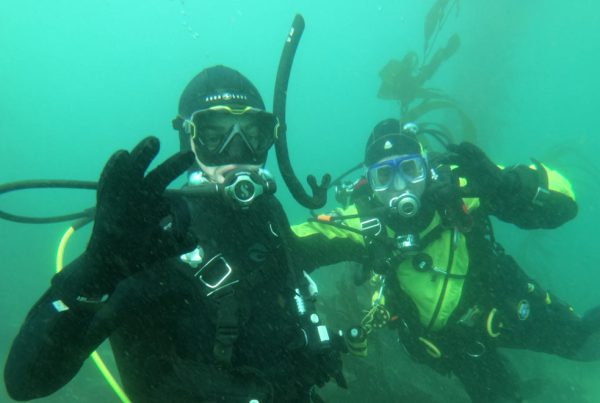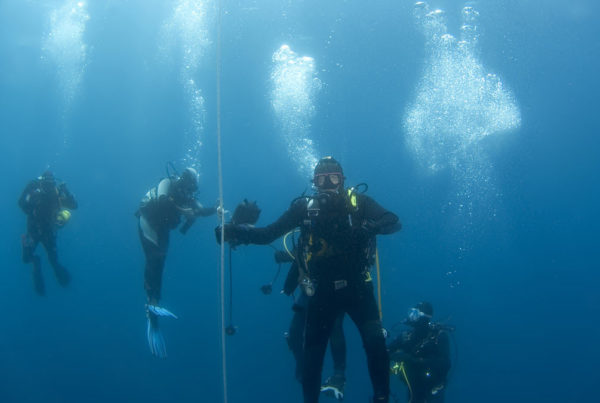Once upon a time, before I took up underwater photography, I was a hunter. Off San Clemente Island one day I happened upon a lobster condo bristling with a million (well, maybe not quite that many) antennae. Kicking like crazy, I rushed the reef, coming to a halt with twitching antenna only inches from my fingertips.
Immobilized, I watched all of the reef’s many inhabitants flip their tails and take flight. Lobsters zoomed by to the left of me and to the right; there were speeding lobsters overhead and under me. I tried to grab those living projectiles but all I got for my efforts were fistfuls of water.
When they were all gone, I figured out what had stopped me. A stringy frond of young kelp had gotten tangled on a fin buckle.
Giant kelp (Macrocystis pyrifera), the largest marine plant on earth, can grow as much as two feet per day. It is a staple of Southern California diving.
Which brings us to The Primary Premise of Diving in Giant Kelp: Sooner or later you will get tangled when you least expect it and always when it is inconvenient.
But there are ways to minimize kelp entanglement. First of all, streamline yourself and your equipment. Reduce the things on which kelp can catch. Tuck accessories in pockets or clip them close to your body. Keep gear worn on arms and legs to a minimum or eliminate it altogether. If you must wear a knife on your leg, wear it on the inside, not the outside.
Here’s a biggie: Don’t jump off a boat into the middle of thick kelp. Almost always the boat will swing into a kelp-free area if you’ll just wait a few minutes. If someone behind you gets impatient, let that person jump into the thick kelp. And if you do jump into thick kelp, don’t compound your mistake by trying to descend in it. While there are techniques that will help you do this, I have found it easier to swim to a clear area, then submerge.
Underwater, watch where you swim. There are always paths through the thickest kelp—underwater and on the surface—so look for them. Look up and choose a kelp-free area before ascending.
Getting unentangled isn’t hard. Don’t panic. Take a deep breath and calm down. Avoid twisting and turning, this will only make things worse. Figure out where you’ve been snagged. Then, remove the offending strand(s). Fin buckles and tank valves are common kelp snaggers.
Don’t pull on kelp wrapped around you or your gear. Stipes (the stem-like portion) are very elastic so pulling on them simply stretches them. Instead, bend the — surprise, surprise, it will break. You can also cut kelp with a knife or snips (scissors). (In 30 years of California diving, I’ve never had to cut myself loose.)
If you must ascend in a thick canopy, all is not lost, you’ll simply have to do the kelp crawl. Once you’ve done that you will probably take extra special care to never, ever do it again. The kelp crawl isn’t hard but it is a pain. There will be great temptation to attempt to power kick your way out of it. Don’t even think of it, it’ll only make things worse.
Instead, inflate your BC so as much of your body is above the surface as possible. (If you’re using a back mounted BC, skip this step.) Then, with your hands in front of you, push down on the kelp and kick gently. Continue doing this. Your progress will be very slow but steady.
While kelp can be a nuisance, it is more often a help. I use it to descend and ascend and to hold onto when I’m making a safety stop. While you’re doing the latter, notice all the animals that depend upon kelp forests for their survival. Certain animals find food and/or shelter in the oldest, others on the stipes, still others on or among the leaf-like blades. Kelp is a good thing: One of the reasons California diving is so incredible.









